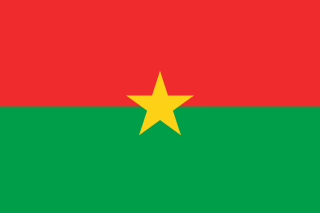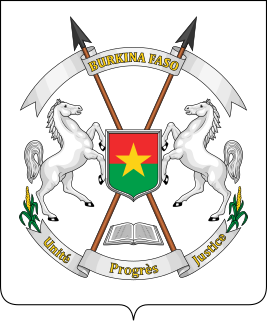
Burkina Faso is a landlocked country in West Africa that covers an area of around 274,200 square kilometres (105,900 sq mi) and is bordered by Mali to the northwest, Niger to the northeast, Benin to the southeast, Togo and Ghana to the south, and the Ivory Coast to the southwest. The July 2019 population estimate by the United Nations was 20,321,378. Previously called Republic of Upper Volta (1958–1984), it was renamed "Burkina Faso" on 4 August 1984 by President Thomas Sankara. Its citizens are known as Burkinabé or Burkinabè, and its capital is Ouagadougou. Due to French colonialism, the country's official language of government and business is French. However, only 15% of the population actually speaks French on a regular basis. There are 59 native languages spoken in Burkina, with the most common language, Moore, spoken by roughly 50% of Burkinabé.

The Volta River is the main river system in the West African country of Ghana. It flows south into Ghana from Bobo-Dioulasso highlands of Burkina Faso. The main parts of the river are the Black Volta, the White Volta, and the Red Volta. In the northwest, the Black Volta forms the international borders between the Ivory Coast, Ghana, and Burkina Faso. The Volta flows southward along Akwapim-Togoland highlands, and it empties into the Atlantic Ocean at the Gulf of Guinea at Ada Foah. It has a smaller tributary river, the Oti, which enters Ghana from Togo in the east. The Volta River has been dammed at Akosombo for the purpose of generating hydroelectricity. The reservoir named Lake Volta stretches from Akosombo Dam in the south to the northern part of the country, and is the largest man-made reservoir by area in the world.

Ouagadougou is the capital of Burkina Faso and the administrative, communications, cultural, and economic centre of the nation. It is also the country's largest city, with a population of 2,453,496 in 2019. The city's name is often shortened to Ouaga. The inhabitants are called ouagalais. The spelling of the name Ouagadougou is derived from the French orthography common in former French African colonies.

Bobo-Dioulasso is a city in Burkina Faso with a population of 903,887 ; it is the second largest city in the country, after Ouagadougou, Burkina Faso's capital. The name means "home of the Bobo-Dioula"; while it was likely coined by French colonists to reflect the languages of the two major groups in the population, it does not capture the complex identity and ethnicity of the location.

The regions of Burkina Faso are divided into 45 administrative provinces. These 45 provinces are currently sub-divided into 351 departments or communes.

The Black Volta or Mouhoun is a river that flows through Burkina Faso flowing about 1,352 km (840 mi) to the White Volta in Dagbon, Ghana. The source of the Black Volta is in the Cascades Region of Burkina Faso, close to Mount Tenakourou, the highest point of the country. Further downstream it forms part of the border between Ghana and Côte d'Ivoire and Burkina Faso. Within Ghana, it forms the border between the Savannah Region and the Bono Region. The Bui Dam is built on the river in Ghana. The river bisects Bui National Park in Ghana.

Ouahigouya is a town in northern Burkina Faso. It is the capital of the Yatenga Province and one of its subdivisions the Ouahigouya Department. It is also the biggest town in the Nord Region. It is the fourth largest city in the country with a population of 124,580 (2019) and is situated 182 kilometres (113 mi) north-west of Ouagadougou.

The Agacher Strip War or Christmas War was a war fought by Burkina Faso and Mali over a 100-mile (160 km) long strip of land along the border in northern Burkina Faso from 25 to 30 December 1985. The war ended in a ceasefire. The Agacher Strip had been subject to a border dispute between Mali and Burkina Faso since the 1960s. Following armed clashes in 1974, both countries agreed to mediation to resolve their differences. Progress on a solution stalled, and in 1983 Burkinabé President Thomas Sankara and Malian President Moussa Traoré decided to have the border dispute settled by the International Court of Justice and subsequently petitioned the body to resolve the issue.

Savanes is the northernmost of the five Regions of Togo. Dapaong is the regional capital. Another major town in the region is Mango.

Kompienga is one of the 45 provinces of Burkina Faso, located in its Est Region.

Est is one of Burkina Faso's 13 administrative regions. It was created on 2 July 2001. The region's capital is Fada N'gourma. Five provinces make up the region—Gnagna, Gourma, Komondjari, Kompienga, and Tapoa.

Pama is a town located in the province of Kompienga in Burkina Faso. It is the capital of Kompienga Province.

The Kompienga Dam is a large hydro-electric dam in Kompienga Province in southeastern Burkina Faso. Constructed between 1985 and 1988, it is the country's first hydro-electric dam and is responsible for much of Ouagadougou's electricity supply. Visitors can obtain a permit to visit the control room of the dam from the state electricity parastatal.

Pama Reserve is a partial reserve in Burkina Faso. Established in 1955 it is located in Kompienga Province and covers an area of 2237 km2. Its eastern border is the Singou river, separating it from two other reserves, Singou and Arli. The western border is the national road N18 from Fada N'Gourma to Porga. In the South the reserve reaches the Pendjari river, being Burkina Faso's border with Benin. The reserve is home to elephants, hippopotamuses, lions and leopards and 450 species of flowering plants.

Pama Airport is a public use airport located near Pama, Kompienga Province, Burkina Faso.
Energy in Burkina Faso is a growing industry with tremendous potential.

Water supply and sanitation in Burkina Faso are characterized by high access to water supply in urban areas, while access to an at least basic water sources in rural areas – where three quarters of the population live – remains relatively low. An estimated one third of water facilities in rural areas are out of service because of a lack of maintenance. Access to at least basic sanitation lags significantly behind access to water supply.

The 2010 Nigerien floods were floods across Niger which left over 111,000 people homeless. Niger was already suffering acute food shortages following prolonged drought in the Sahel region. As of 24 August 2010, at least 6 to 8 people had died. The Niger river was pushed to its highest levels in 80 years. The floods subsequently spread along the River Niger into Nigeria, Ghana, Burkina Faso, Togo and Benin over the next few months. Later storms also brewed up in the CAR, Morocco and northern Algeria.

Burkina Faso–India relations refers to the international relations that exist between Burkina Faso and India. Burkina Faso maintains an embassy in New Delhi. India maintained an embassy in Ouagadougou from November 1996 until its closure in July 2002. Currently, India maintains an honorary consulate in Ouagadougou, which functions under the jurisdiction of the High Commission of India in Accra, Ghana.

















